To further group trees into distinctive categories, they are classified as either hardwood or softwood. Softwood trees are usually those that produce needles, such as pine trees. These trees are evergreen, keeping their foliage throughout the winter months. On the other hand, hardwood trees are typically deciduous, dropping their leaves during the fall and winter months. In other words, the definition of a hardwood is wood that comes from a deciduous tree. The biology of a tree helps determine its classification as a hardwood or softwood tree. The density and weight of the wood also provides a classification.
Hardwoods generally have broad leaves and often have dark-coloured wood. They normally have higher densities and thicker cell walls than softwoods. There are a much greater number of hardwood species than there are softwoods. Some examples of hardwood include: oak, ash, elm, beech, birch and teak.
Within the softwood and hardwood groups, there is a considerable variation in actual wood hardness, the range of density in hardwoods completely, including that of softwoods. Some hardwoods (such as balsa) are softer than most softwoods, while the hardest hardwoods are much harder than any softwood. In short, the terms softwood and hardwood are archaic with questionable meaning and often belie the properties of the wood.
- Ash trees
- Beech trees
- Birch trees
- Black Cherry Trees
- Black walnut trees
- Cottonwood trees
- Elm Trees
- Hickory trees
- Holly trees
- Magnolia tree
- Oak trees
- Poplar Trees
- Sycamore Trees
- Walnut Trees
- Sassafras trees
- Sweetgum trees
- Willow trees
- Alder trees
- Balsa trees
- Hackberry
- Black Locust
- Maple Trees
- Mahogany
- Teak
- Rosewood
- Sapele
- Yellow Poplar
- Sandalwood
- Shisham
- Sal
Ash Trees
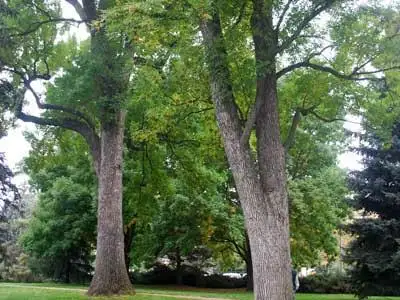
Ash is a light colored, smooth-grained hardwood that grows throughout the east coast and parts of Canada. With its typical straight grain and beige-to-light-brown hue, ash wood is a very attractive option for fine furniture. Most ash trees are small to medium in height, though some of the larger timber-providing species grow to 18–34 metres (60–120 feet). The leaves of ash trees are opposite, usually deciduous, and pinnately compounds with an odd number of leaflets often five to nine. The narrow fruits are one-seeded and winged. The flowers usually are small and grow in showy clusters, and some species have petaled blooms.
Beech Trees
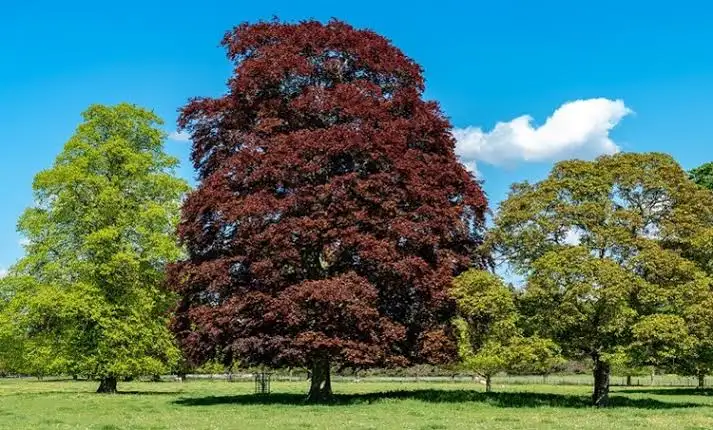
The beech tree has a naturally attractive growth habit, with one central trunk that grows straight up and through the tree’s crown. Beech wood is primarily reddish-brown in color and slightly coarse with conspicuous rays and tiny pores. The grain is straight with a fine, even texture. It’s easy to recognize a beech tree by its smooth, gray bark, which the tree keeps throughout its lifespan. When grown in an open site, it develops a pleasing shape, with a broadly rounded crown and openly spreading branches. The toothed parallel-veined leaves are shiny green and are borne alternately along the stem. Yellow-green male flowers hang from threadlike stems.
Birch Trees
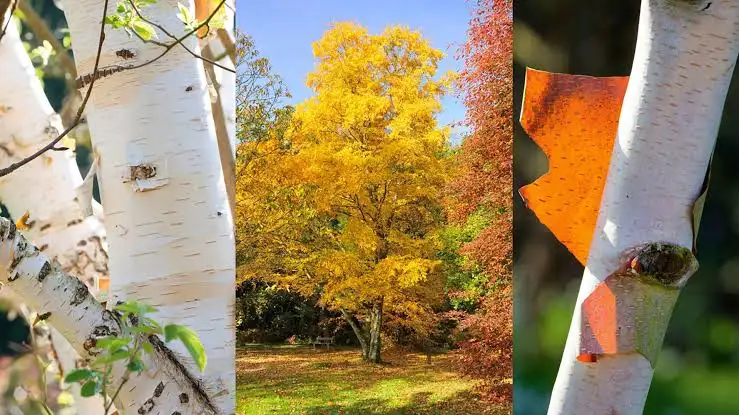
The birch tree grows all over the world and is popular for its wood, bark, and extracts.The birch wood tree typically grows to be around 90 feet tall with a diameter of two feet across. In some instances, birch trees may grow to be near 100 feet tall and have a three-foot diameter. The bark of the birch wood tree appears a white or cream-like color and the interior heartwood is a golden brown. The outer bark of the birch wood tree is resinous and curly, becoming more thick, hard, and ridged as it ages. The pores of the inner heartwood are closed and do not give off a significantly noticeable odor. Birch is a fine-grained wood with a uniform texture, making it easier to work with than other species of hardwood trees. Birch is also a heavy wood with good crushing strength and shock resistance.
Also Read: Fast Growing Shade Trees To Try At Home
Black Cherry Trees
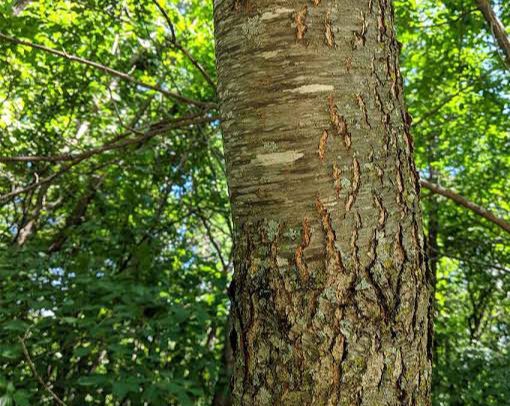
Black Cherry also known as wild cherry is a deciduous tree that may grow 60 to 80 feet tall and is commonly found in forests. It displays fragrant white blooms in early spring and reddish-black berries in summer. The large, dark green leaves turn yellow, orange and red in autumn. The bark of young trees is smooth and reddish-brown, maturing to an interesting scaly texture. Black cherry is valued for its many ornamental and practical uses. The wood of black cherry is valuable for making furniture and cabinets. The strong, hard wood of this tree is close-grained. It is also used to make paneling, veneers, interior trim, toys and scientific instruments.
Black Walnut Trees

Black walnut is a native hardwood tree that is often planted in large-scale landscapes and valued as a lumber tree.Black walnut trees grow quickly in the first several years, until the tree begins to approach its mature size. Black walnut trees grow a single main trunk that produces several large branches up the length of the trunk. The foliage of the tree typically develops into a rounded shape that spreads 60 to 80 feet. These trees commonly reach 70 feet in height but may grow up to 150 feet tall. The black walnut grows well in a variety of conditions but performs best in open areas where the sun shines brightly throughout the day.
Cottonwood Trees
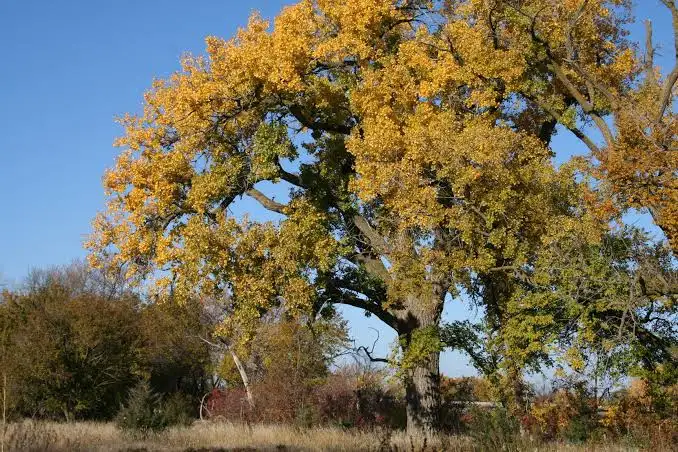
Cottonwood trees are fast-growing hardwood majestic trees, member of poplar family, whose timber is commonly used for shelving, framing, paneling, sub floors, crates, pallets, lowboy decks etc. The leaves of cottonwood trees are triangular with a heart-shaped base that tapers to a long-pointed tip. They flutter in the breeze, adding motion and color to the yard. In the fall, the leaves turn a brilliant gold. Cottonwoods are large trees, topping 60 to 80 feet, and they require plenty of moisture. The bark of younger trees is rather smooth and greenish-gray. On older trunks, it becomes ashy-gray and is roughened by long, deep, longitudinal and interconnecting furrows. In the wild, cottonwood grows along rivers, ponds and other bodies of water. It also thrives in floodplains and dry riverbeds, where infrequent rains transform dry land into waterways.
Elm Trees
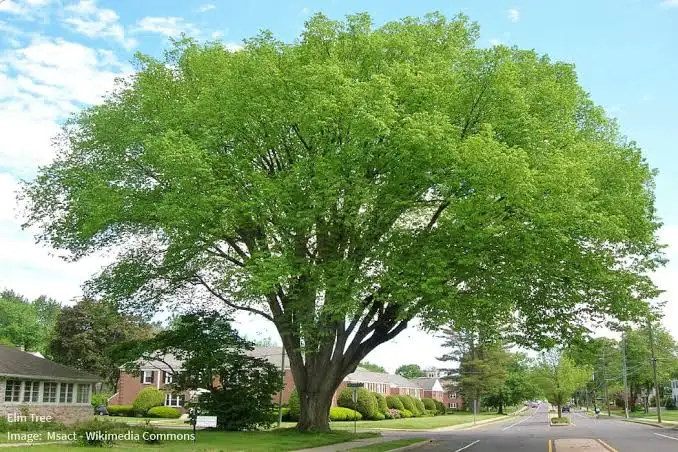
Elm trees are deciduous trees that reach 80 to 100 feet tall and 60 to 120 feet wide at maturity. The textured, grey trunk of an elm tree can be as much as 4 to 7 feet wide. American elm trees have textured, deep green leaves with saw-toothed edges. The leaves turn a brilliant yellow hue in the fall before dropping in the winter. Elm trees thrive in many different soil types and conditions, so long as the soil drains properly and the tree receives full sun to partial shade. Elm wood is strong and durable with a tight-twisted grain, and is resistant to water. It has been used in decorative turning, and to make boats and boat parts, furniture, wheel hubs, wooden water pipes, floorboards and coffins.
Also Read: Different Types of Birch Trees For Landscaping
Hickory Tree
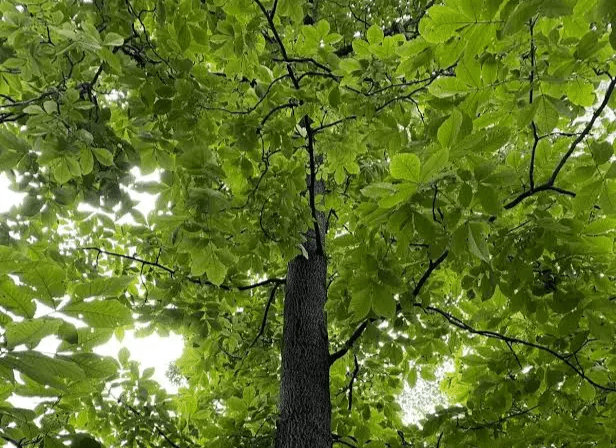
Hickory trees are also grown for shade, for their hard wood, and as a habitat for birds and other small animals.All hickories reach heights of 50 to 100 feet at maturity with a spread of roughly 40 feet and live for many years. Unless grown commercially, most hickories do not grow in stands but appear individually scattered across a wide area among other trees such as maples, oaks and pines. The wood of this tree is prized for its hardness and density. Its shock resistance makes it an excellent wood used as fuel and for tool handles, sports equipment, furniture, and flooring. Better grades of hickory wood are also used to build furniture and in the manufacture of wall paneling.
Holly Trees
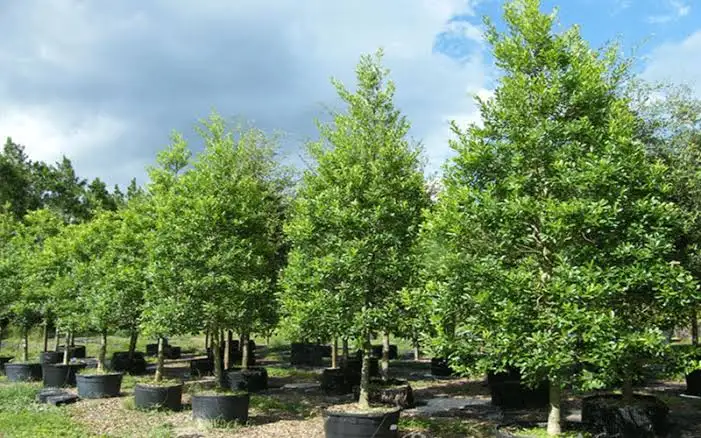
Holly can often reach up to almost 30 metres as a mature tree and are identified by their silky, green leaves with sharp spikey edges, although these dull as the tree ages. Hollies are naturally dioecious, meaning that both male and female plants must be present to produce those familiar berries that are so attractive to birds. The wood of Holly was used in joinery, cabinet making, engineering, the making of mathematical instruments, wood engraving and veneering. The wood is essentially white (except for the heart wood) and accepts dyes readily – so when dyed black, it was sometimes used as a substitute for ebony (on the handles of tea pots).
Magnolia Tree

The magnolia is a pyramidal shaped, evergreen tree adaptable to many different soil types and water conditions.The leaves of the magnolia tree are 5 to 8 inches in length and 2 to 3 inches in width. This relatively large tree grows between 60 to 90 feet in height with a trunk that is approximately 4 feet in diameter. The flowers of the magnolia tree bloom throughout the summer months. These creamy white flowers with purple centers are roughly 7 to 10 inches in diameter. Magnolias are classified as a hardwood tree, their wood is creamy in color and often used for crafting and decorative purposes. It is occasionally cut and used as firewood. The bark of the magnolia tree is gray-brown in color. It is smooth in texture when the tree is young; however, the bark of an older magnolia tree is often rougher or scaly in texture.
Oak Trees

Oak trees do not usually have a single, straight leader after branching begins, but spread out into several large branches. If the oak does have a single trunk it is rarely straight after branching. Oaks also tend to be as wide as they are tall when given enough room, but growing conditions have a larger effect on this than species. An oak growing in the forest will be tall and thin like its neighbors, while oaks growing in large, even spacing along a planted row are short and wide. Oak is an important timber tree, producing prime hardwood lumber with a fine, almost watertight grain. Its hard, heavy, tough wood is used for beams, railroad ties, flooring, barrels, furniture and other products.
Also Read: Trees With White Bark
Poplar Trees

Poplar trees are a popular species among homeowners, gardeners and farmers in part due to their fast growth and hardy nature. Most of Poplar trees have an upright, columnar form, attractive bark and triangular leaves that quiver in the breeze. Poplar is a hardwood, but it isn’t a hard wood. Poplar wood is lightweight and easy to work, making it an ideal utility wood. Its color is creamy yellow to yellowish brown, and it has a straight, muted grain. All these qualities suggest that it would be good wood for cabinetry and interior trim, but its low density and porosity create fuzziness on the surface and edges that is difficult to sand out.
Walnut Tree
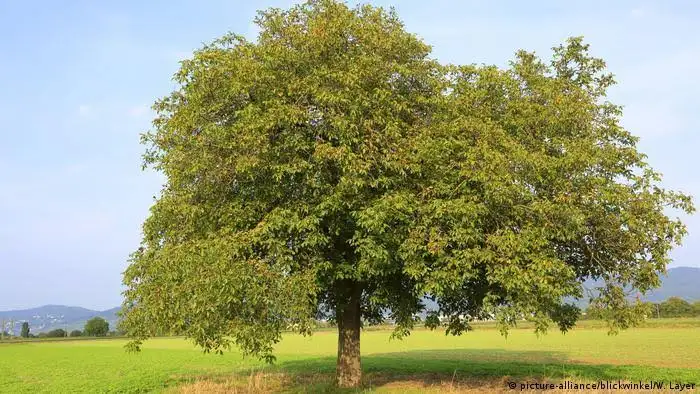
Walnut trees are valued for their dark, durable wood and highly nutritional nuts. Walnut trees grow quickly in the first several years, until the tree begins to approach its mature size. Black walnut trees grow a single main trunk that produces several large branches up the length of the trunk. The foliage of the tree typically develops into a rounded shape that spreads 60 to 80 feet. These trees commonly reach 70 feet in height but may grow up to 150 feet tall. Walnut wood is hard, dense and tight-grained. It’s prized by woodworkers for its strength, grain and color. It polishes to a very smooth finish, and the color ranges from creamy white in the sapwood to a dark chocolate in the heartwood.
Sweet Gum Trees
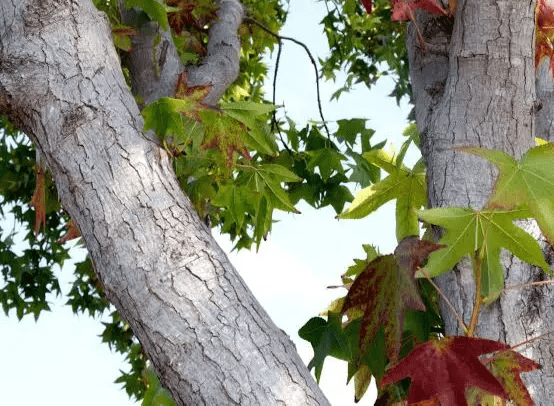
Deciduous sweet gum trees go by many other names, including star-leaved gum, redgum, storax and alligator wood. Sweet gum trees make beautiful additions to landscapes. Their size and large, full crowns provide abundant shade to gardens, sidewalks, parks and streets. Their foliage takes on a range of fall colors, including orange, to yellow, red and purple, livening up the landscape. Sweet gum trees also serve as privacy barriers and provide seclusion in gardens. Sweetgum wood is a relatively hard, uniform grained wood that can be used for furniture and plywood.
Willow Trees
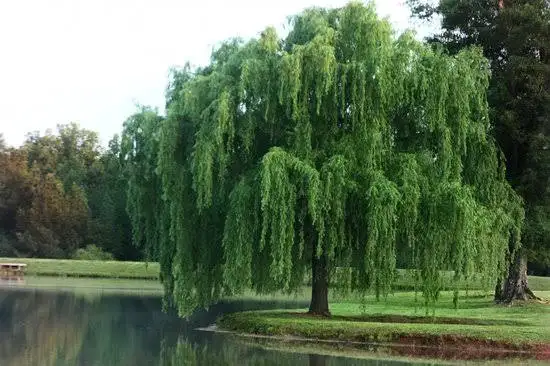
Willows, also called sallows and osiers. Depending on the pecies, willows range in size from low-ground-hugging shrubs to towering giants of 90 feet or more. In landscapes, willows are often planted alongside streams where the interlacing roots will hold back soil and prevent erosion.The wood of willow trees tends to be brittle, so ornamental landscape use is limited to a relatively few species. Willow wood is also used in the manufacture of boxes, brooms, cricket bats, cradle boards, chairmans and other furniture, dolls, willow flutes, poles, sweat lodges, toys, turnery, tool handles, wood veneer, wands and whistles. In addition, tannin, fibre, paper, rope and string can be produced from the wood.
Also Read: Different Types of Softwood Trees You Need Know
Alder Trees
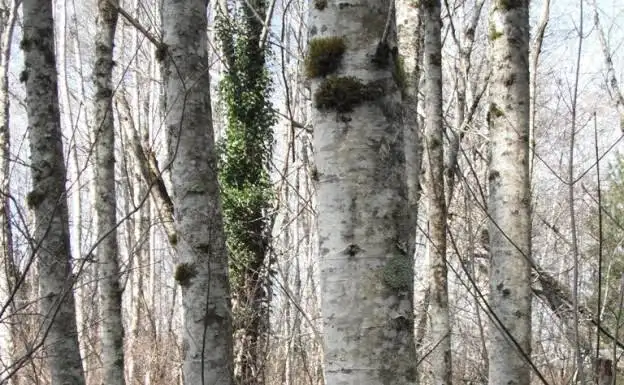
The deciduous Alnus glutinosa tree, usually referred to as black alder, common alder or European alder, brings more to your landscape than its well known lush greenery and vibrancy. Although classified as a hardwood, alder is one of the softest of all hardwoods and is more commonly referred to as a semi-hardwood. On a hardness scale, alder ranks just above pine and poplar. Alder has a light brown color with subtle grain patterns that are straighter than other hardwoods, such as oak or ash. Due to its weight, structural integrity and affordability, alder is often used as an internal framing material on other types of woodworking projects.
Balsa Trees

The balsa tree is a deciduous or evergreen tree with smooth, grey-white bark that grows around 40m tall. The large leaves are weakly palmately lobed, and grow 30 to 40cm across. The balsa tree produces a creamy white wood that when dried has a density of just 7.5 pounds per cubic foot, one of the lightest species of wood available. This wood had superior strength compared to other light-density woods and was once used to build airplanes. It continues to find use in model airplanes and has other woodworking uses.
Hackberry Tree
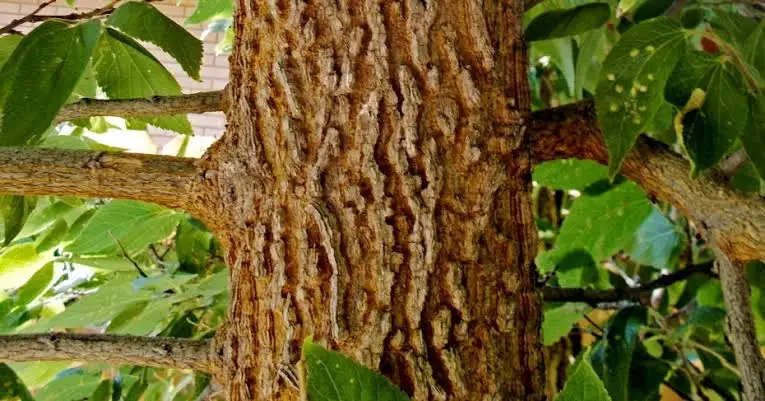
Hackberry is a tree with an elm-like form and is, in fact, related to the elm. Hackberry forms a rounded vase reaching a height of 40 to 80 feet. The mature bark is light gray, bumpy, and corky, while its small, berry-like fruit turns from orange-red to purple and is relished by birds. Hackberry is commonly found on roadsides and in forested areas. It will make a great shade tree for any acreage or landscape setting. Hackberry is a commercial timber species. The wood is used in furniture construction, boxes, crates and pallets.
Black Locust
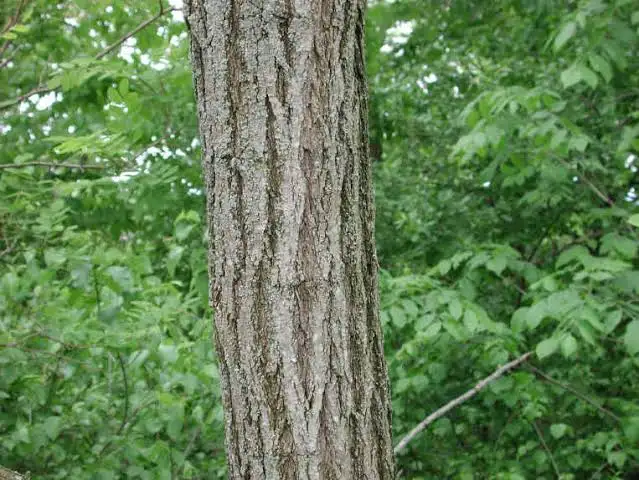
Black locust is a fast-growing tree that quickly reaches a height of 65 feet. These deciduous trees have long compound leaves, made up of up to 21 leaflets, and many species contain thorns. They flower in loose clusters and produce long legumes as fruit. Black Locust is a very hard and strong wood, competing with Hickory (Carya genus) as the strongest and stiffest domestic timber: but with more stability and rot resistance. Besides its use as a constructional timber for special applications, black locust wood is also used in barrels, tool handles, fences, posts and bars. Because it is an excellent wood for turning, it is used for making nails for ships, in glazing and shoe-making tasks, and for sports equipment.
Also Read: Different Types of Evergreen Trees For Your Yard
Mahogany

The mahogany tree is a large tropical tree with a semi-evergreen growth habit. Mahogany trees produce broad, spreading growth with foliage that can span 50 feet in width and 75 feet in height at maturity.A mahogany tree’s foliage forms a roughly symmetrical, round canopy. Although the tree grows from a single trunk, the main trunk branches off into several large stems that spread out and up from the main trunk starting 4 to 8 feet above the ground. Mahogany trees have a moderate to fast rate of growth compared to other trees. Mahogany is a hardwood with a fine grain and attractive red colouring. It is a versatile wood suitable for engineering applications and for use in construction.
Teak Tree

Teaks are hardwood trees that grow can grow to 150 feet (46 m.) tall and live for 100 years. Teak tree leaves are reddish green and rough to the touch. Teak trees shed their leaves in dry season then regrow them when it rains. The tree also bears flowers, very pale blue blossoms arranged in clusters at the branch tips. Teak is renowned for its toughness and resistance to moisture. The wood is as durable as most varieties of oak, and at the same time is so thick with natural oils that it is almost immune to moisture and rot under normal circumstances.Teak is mainly used in the manufacture of outdoor (garden) furniture, boat decks and other equipments where weather resistance is desired.
Further References
- What Are Hardwood Trees?: https://www.gardeningknowhow.com/ornamental/trees/tgen/hardwood-tree-information.htm
- Common Hardwood Trees: https://www.treehugger.com/identification-of-the-most-common-hardwoods-1341843
- Example of Hardwood Trees: https://www.progardentips.com/types-of-hardwood-trees/
- Difference Between Hardwood And Softwood Trees: https://www.laver.co.uk/blog/hardwood-vs-softwood-whats-the-difference
- Hardwood Vs Softwood Trees: https://www.diffen.com/difference/Hardwood_vs_Softwood